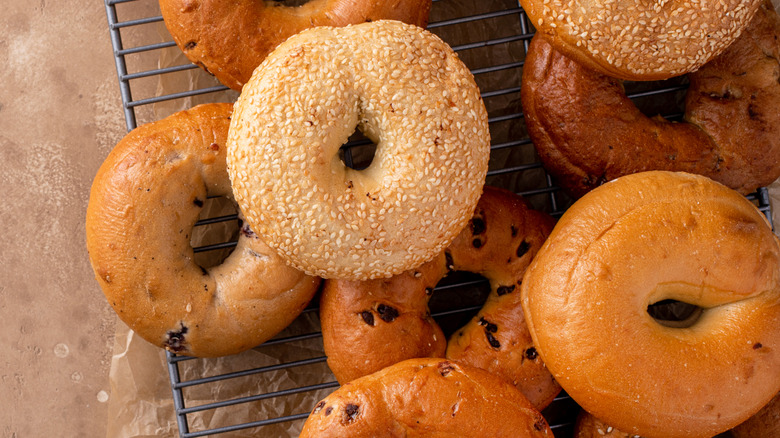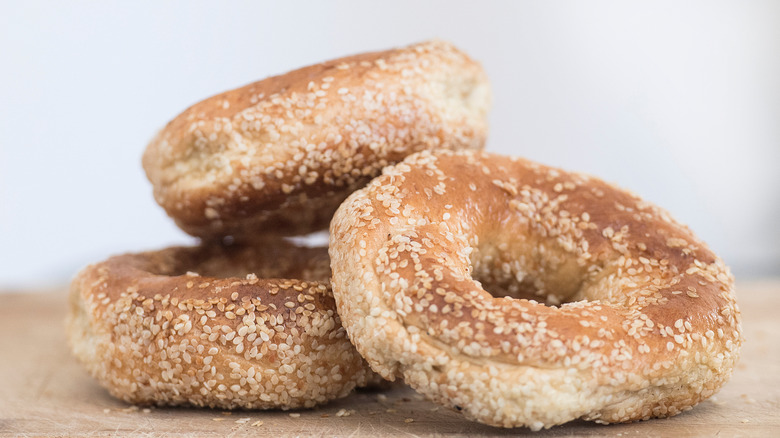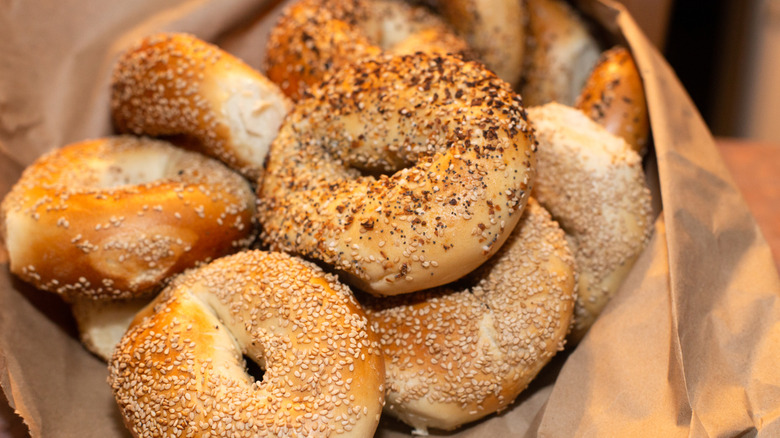What Really Sets Montreal And New York Bagels Apart
You might not know it, but there is a boiling breakfast battle going on in North America, and it's all centered around the bagel. The two main contenders in this United States vs. Canada standoff are New York and Montreal. They aren't competing with simple bagel variations — they both have extremely different approaches to bagel making, which results in two very different eating experiences.
The differences go far past just size; they factor in the ingredients used, the way the dough is prepared, how they're cooked, and even the water that's used. Understanding these differences helps appreciate why each city's bagels have such a devoted following. While both styles share the common step of being boiled before baking (which is a key to that amazing chewy texture), almost everything else makes them different. When it comes to these bagels, it's not just about bread, it's about tradition, local pride, and the perfect bite.
The sweet, thin, and slightly smoky Montreal bagel
The Montreal bagel is known for its sweetness and a smaller and thinner density when compared to an NY bagel. it also has a larger hole in the center. The dough itself often contains honey, and it's always boiled in honey-sweetened water before baking, which contributes to the bagel's overall sweetness. Another key difference is the absence of salt in the traditional recipe. Montreal bagels are baked in wood-fired ovens, giving a slightly smoky flavor and a crisp, sometimes slightly charred edge. The heat of the wood fire combined with the honey-sweetened water results in a bagel that's chewy, crispy, and a little sweet.
The history of the Montreal bagel traces back to Jewish immigrants from Eastern Europe, particularly Poland and Russia, who arrived in Montreal in the late 19th and early 20th centuries. They brought with them their traditional baking styles, and the bagel quickly became a local staple for places to eat in Montreal. Originally, bagels were often sold from carts or wagons and became an integral part of the city's food scene. The two most common varieties you'll find are sesame seed and poppy seed, though other types can be ordered.
There's something in the water with New York bagels
The New York bagel is known for its larger size, chewiness, and, honestly, for its reputation as the best bagel in the world. It has a smaller hole compared to the Montreal bagel and a noticeably less sweet taste. The dough typically includes flour, yeast, salt, water, and barley malt syrup, which contributes to the bagel's iconic flavor.
The boiling process is a big step, but New York bagels are typically boiled in water that contains malt and sometimes baking soda. This helps to gelatinize the starches on the surface, creating that chewy crust and a filling center. After boiling, they are baked in conventional ovens, not wood-fired ones.
There's a long-standing myth and a scientific reason why New York City's tap water is the secret ingredient to its bagels. The water is known for being "soft," meaning it has a low mineral content, which affects how the gluten in the dough develops. New York bagels, like Montreal's, come from Jewish descent. New York's Jewish baker's union increased the popularity of bagels in the 1960s. Innovations like the rotating oven changed the way bagels were made and allowed bakeries to produce more. While you can find classic flavors like plain, sesame, and poppy seed, New York bagel shops are known for their wide variety of options, from salt (which Montreal doesn't use), to the trendy rainbow bagels found throughout the Big Apple.



